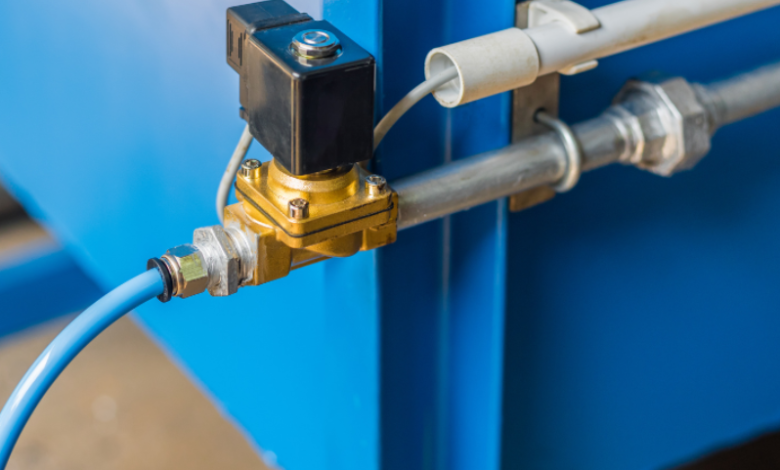Vacuum Solenoid Valve: How It Works in Factory Lifting Systems

A vacuum solenoid plays an important role in factory lifting systems by controlling the flow of air to create precise suction and release mechanisms. These valves ensure that materials are handled safely and efficiently, enabling automated lifting and positioning in manufacturing environments. In this article, we’ll explore the working principles of vacuum solenoids, their key applications, and why they are essential for modern industrial operations.
What Is a Vacuum Solenoid Valve?
A vacuum solenoid valve is an electrically controlled on/off valve that manages the flow of air or gas in systems operating under vacuum. It works by using an electric coil to move a plunger, which opens or closes a passage that controls airflow.
Here’s how it works:
- When energized, the coil creates a magnetic field that moves the plunger to open or close the valve, allowing vacuum flow.
- When de-energized, the magnetic field disappears, and the spring pushes the plunger back to its resting position, stopping or venting the vacuum.
The valve works like a switch, turning suction on or off as needed. This is essential for safely and efficiently lifting and moving objects in automated vacuum systems.
Basic Operation: How It Controls Airflow
A vacuum solenoid valve acts like an electric switch that controls vacuum flow, turning suction on or off as needed.
- Rest State:
- If the valve is Normally Closed (NC), it blocks airflow, so no suction occurs.
- If Normally Open (NO), vacuum flows freely until powered.
- Activation: When electricity flows through the coil, it creates a magnetic force that pulls the plunger. This movement opens or closes the air path, which starts or stops the suction in the system.
- Vacuum Operation: When the valve is open, air is drawn out of the system, creating suction that holds the load securely.
- Deactivation: The valve stops vacuum flow and releases the load when power is turned off.
The valve accurately controls vacuum flow, allowing safe and efficient handling in automated systems.
Types of Vacuum Solenoid Valves
The main types of vacuum solenoid valves differ in operation and application, helping you choose the right one for specific system needs.
- Direct-Acting Valves
Direct-acting vacuum solenoid valves use the magnetic force from the coil to move the plunger directly. This movement directly opens or closes the valve seat without relying on system pressure.
When they’re used:
- For low-pressure and low-flow vacuum applications.
- When fast response and simple design are priorities.
- In small vacuum systems or setups with light loads.
Key points:
- Work even when pressure differences are small.
- Simple and reliable design with quick response times.
- Limited flow capacity compared to other types.
- Pilot-Operated (Servo-Assisted) Valves
Pilot-operated valves use the solenoid to open a small pilot passage, allowing the system’s own pressure or vacuum differential to move the main valve. The solenoid triggers the action, but the system pressure does most of the work.
When they’re used:
- For high-flow or large-volume vacuum systems.
- When larger orifices are needed to move more air or gas.
- In systems with enough vacuum or pressure differential to assist operation.
Key points:
- Can handle larger flow with less electrical power.
- Require a minimum vacuum differential to work properly.
- Slightly more complex than direct-acting valves but ideal for heavy-duty applications.
- Three-Way Valves
Three-way solenoid valves have three ports, usually consisting of:
- One for the vacuum source.
- One for the load (suction cup or device).
- One for atmosphere or vent.
They let you switch between vacuum and atmosphere, or between two vacuum sources.
When they’re used:
- For applications that need suction and release in one device.
- In vacuum grippers, they pick up objects under vacuum and then release them by venting to air.
- When more control over airflow direction is required.
Key points:
- Provide flexible control.
- Slightly more complex design, but ideal for automation and material handling.
- EuroTECH’s product range includes directly controlled 3/2-way solenoid valves, a common type of three-way valve
Each type of vacuum solenoid valve has a specific function, and selecting the right one depends on your system’s vacuum level, flow rate, and control needs.
See also: New Office Viewing: Technical Elements to Look Out For
Key Factors to Consider When Selecting a Vacuum Solenoid Valve
Here’s a simple guide to help you choose the right vacuum solenoid valve for efficient and reliable system performance:
- Vacuum System Specifications
- Pressure Range: Know the maximum and minimum pressures your system requires.
- Flow Rate: Determine how much air or gas needs to pass through the valve per minute or hour.
- Temperature: Ensure the valve can handle your system’s operating temperatures, especially if it’s very hot or cold.
- Valve Type
- Direct-Acting Valves: Best for low-pressure, low-flow systems that need quick responses.
- Pilot-Operated Valves: Ideal for high-pressure, high-flow systems, using system pressure to assist operation.
- Three-Way Valves: Used to switch between vacuum and air, useful for applications like vacuum grippers.
- Material Compatibility
- Valve Body: Common materials are stainless steel, brass, and aluminum. Choose based on strength, weight, and corrosion resistance.
- Seals: Seals should be made of materials compatible with your system’s media and temperature, such as nitrile, FKM, or EPDM.
- Corrosion Resistance: For harsh environments with chemicals or moisture, pick materials that resist corrosion.
- Electrical Specifications
- Voltage: Ensure the valve’s coil voltage matches your system.
- Duty Cycle: Decide if the valve will run continuously or intermittently, which affects its lifespan and heating.
- Connector Type: Check that the valve’s connectors are compatible with your wiring and control system.
- Durability and Harsh Condition Resistance
- Environmental Factors: Consider dust, moisture, or chemical exposure.
- Mechanical Stress: Factor in vibrations or shocks that the valve may experience.
- Maintenance Needs: Choose valves that are easy to service to reduce downtime and costs.
Choosing the right vacuum solenoid valve based on system needs, type, materials, electrical specs, and durability ensures reliable operation.
Applications in Factory Lifting Systems
Vacuum solenoid valves carefully control when suction starts and stops in robotic lifting systems. Here’s how they help in different applications:
- Robotic Lifting Arms:
Vacuum solenoid valves control suction in robotic grippers, allowing robots to lift and move objects safely and precisely. This ensures accurate pick-up and release during packaging or material handling tasks. - Pick-and-Place Systems:
Vacuum solenoid valves help robots quickly and accurately handle items in automated systems. This improves speed, precision, and overall efficiency in material handling. - Conveyor and Packaging Automation:
Vacuum solenoid valves control suction at key points on conveyor systems, allowing products to move automatically and smoothly while reducing manual handling. - Handling Fragile or Heavy Materials:
Vacuum solenoid valves control suction precisely, allowing delicate or heavy items like glass panels or metal sheets to be moved safely without damage.
Vacuum solenoid valves are essential in modern factory lifting systems. They improve automation, efficiency, and safety while allowing precise handling of both delicate and heavy materials.
Benefits of Using Vacuum Solenoid Valves
Vacuum solenoid valves are essential for modern factory automation because they control suction and airflow. Here are their main benefits:
- Precise Suction and Airflow Control
Vacuum solenoid valves ensure consistent and accurate gripping, protecting fragile or heavy materials during handling.
- Automation of Repetitive Tasks
Vacuum solenoid valves speed up operations by automating lifting and releasing, reducing manual labor and improving consistency.
- Improved Efficiency, Safety, and Reliability
Vacuum solenoid valves speed up processes by reducing cycle times and minimizing human error. Their reliable performance helps create safer work environments and maintain consistent product quality.
- Less Manual Labor and Fewer Errors
Using these valves for automation means less reliance on people, which lowers mistakes and labor costs. Workers can focus on more complex tasks, while production becomes faster and more accurate.
Vacuum solenoid valves are key components in factory automation, improving precision, efficiency, safety, and overall cost-effectiveness.







